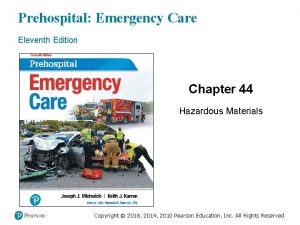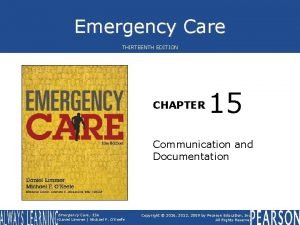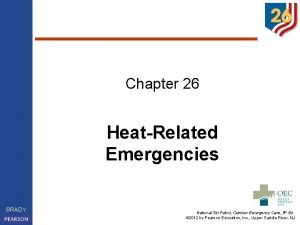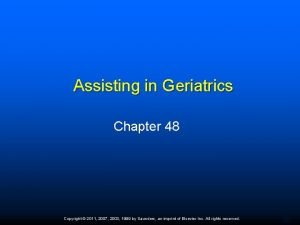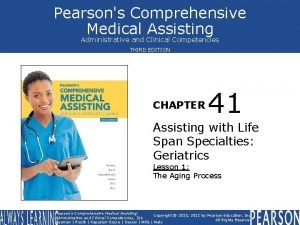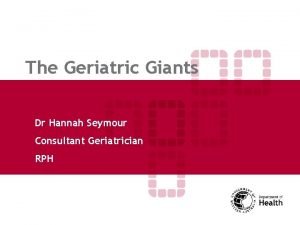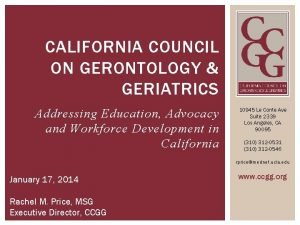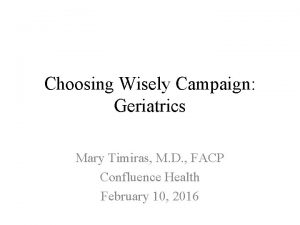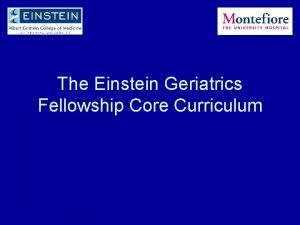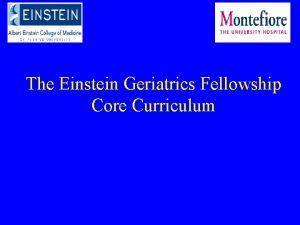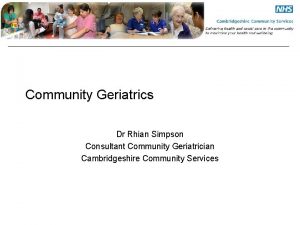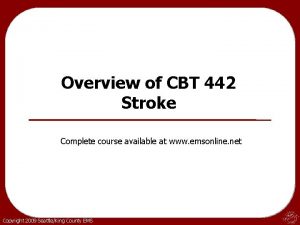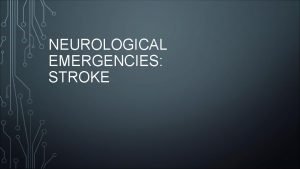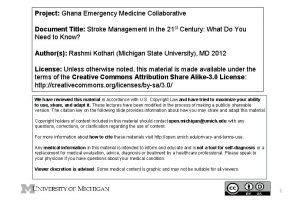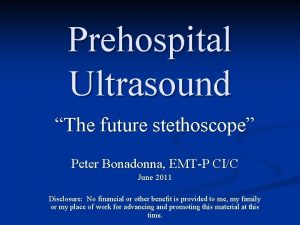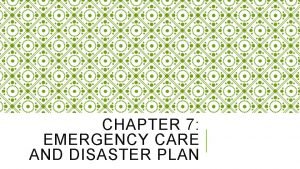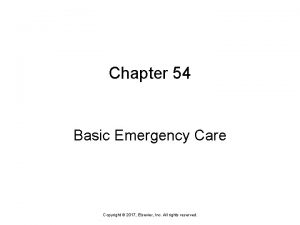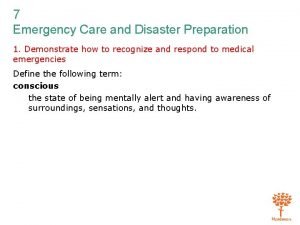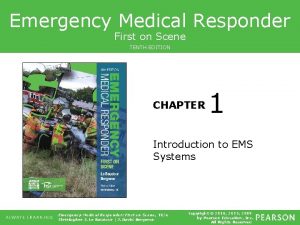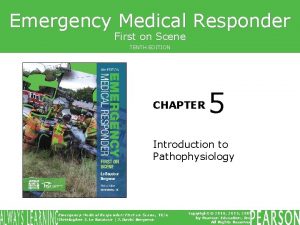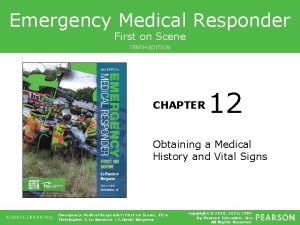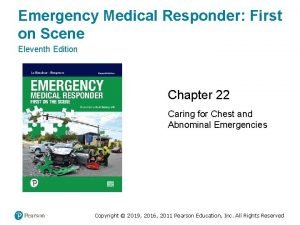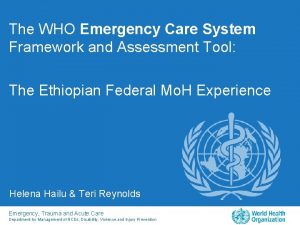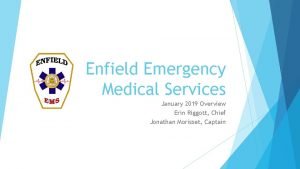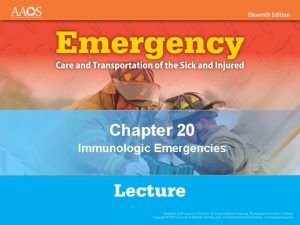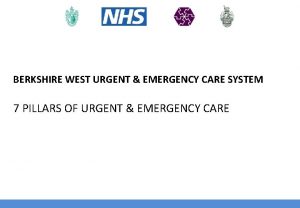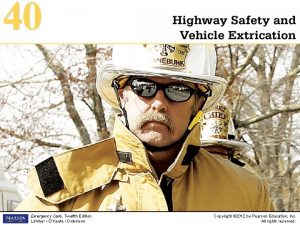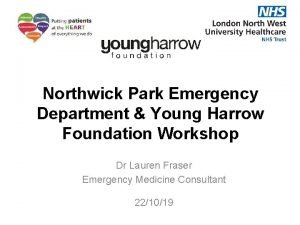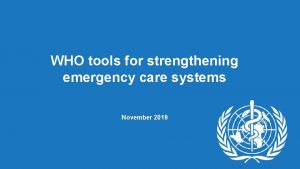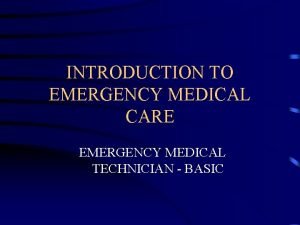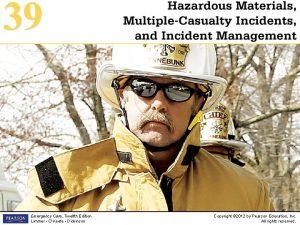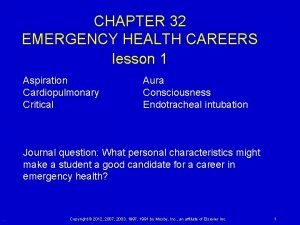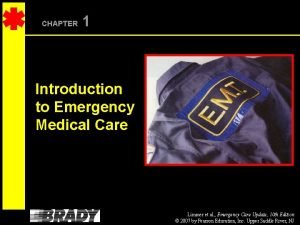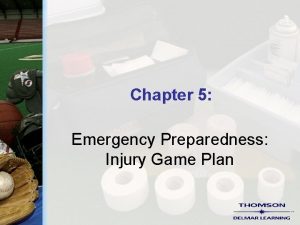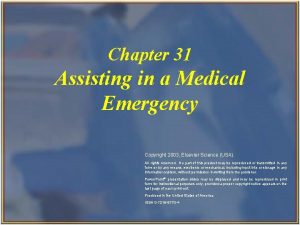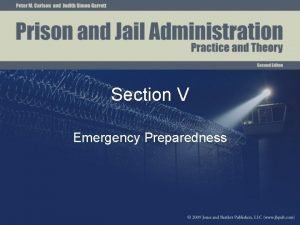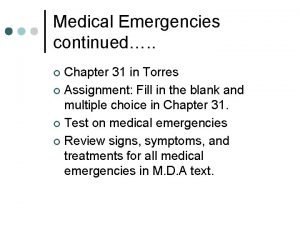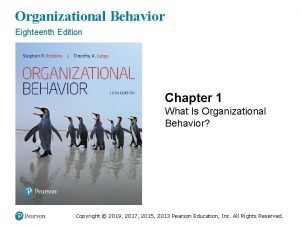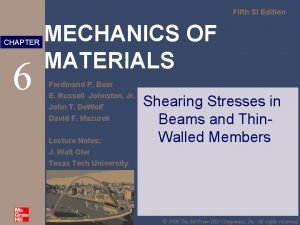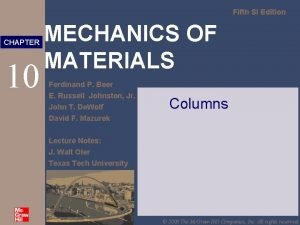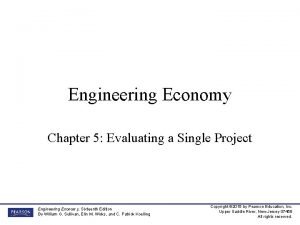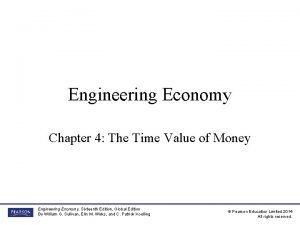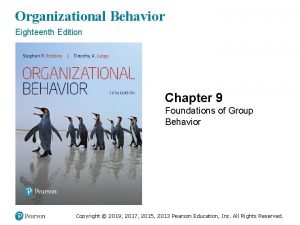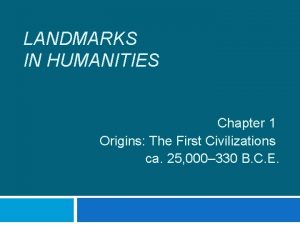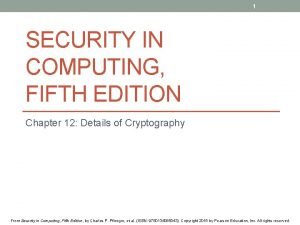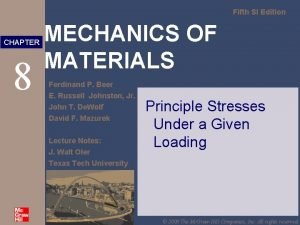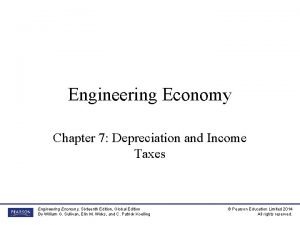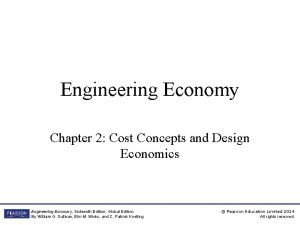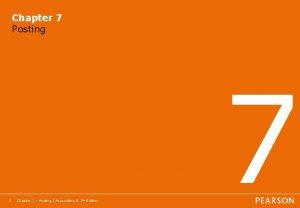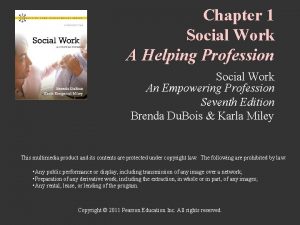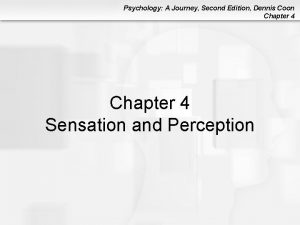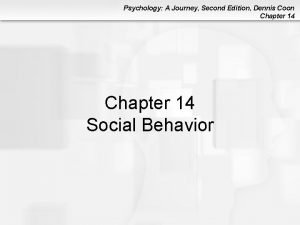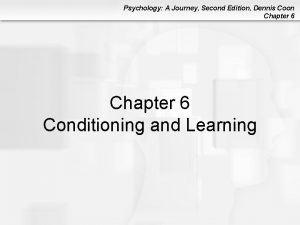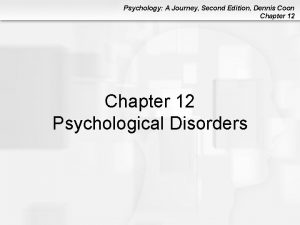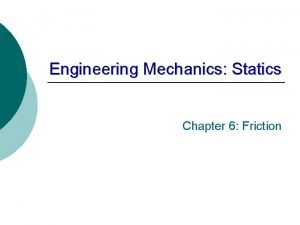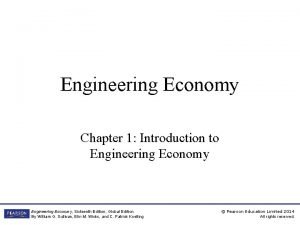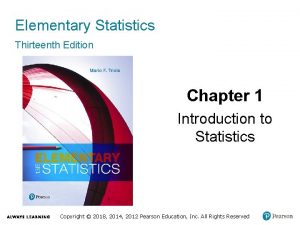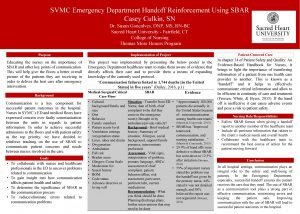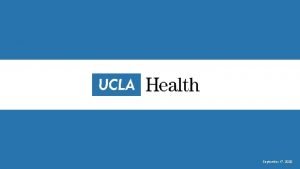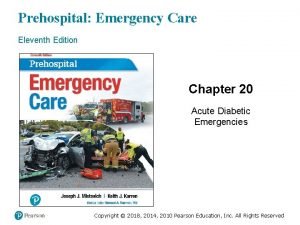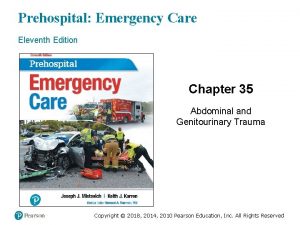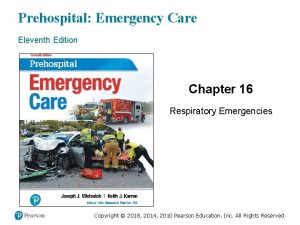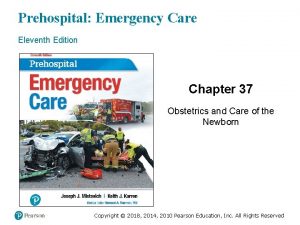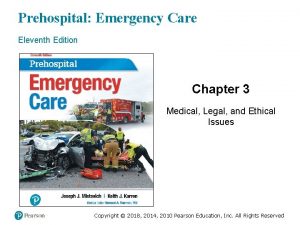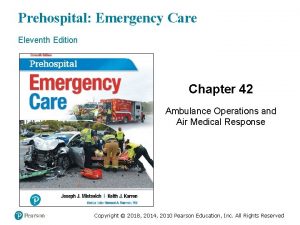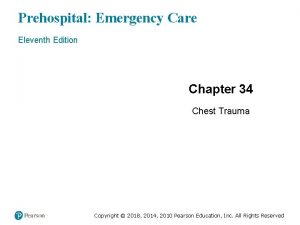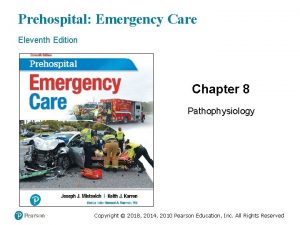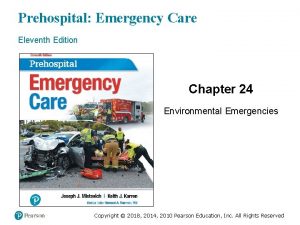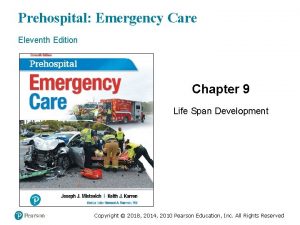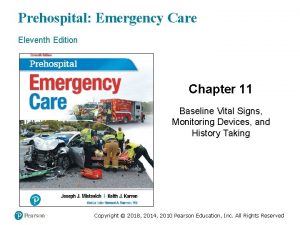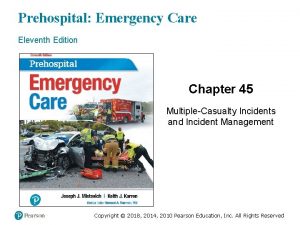Prehospital Emergency Care Eleventh Edition Chapter 39 Geriatrics











































































































- Slides: 107

Prehospital: Emergency Care Eleventh Edition Chapter 39 Geriatrics Slides in this presentation contain hyperlinks. JAWS users should be able to get a list of links by using INSERT+F 7 Copyright © 2018, 2014, 2010 Pearson Education, Inc. All Rights Reserved

Learning Readiness • EMS Education Standards, text p. 1181. • Chapter Objectives, text p. 1181. • Key Terms, text p. 1181. • Purpose of lecture presentation versus textbook reading assignments. Copyright © 2018, 2014, 2010 Pearson Education, Inc. All Rights Reserved

Setting the Stage • Overview of Lesson Topics – Effects of Aging on Body Systems – Special Geriatric Assessment Findings – Assessment-Based Approach—Geriatric Patients Copyright © 2018, 2014, 2010 Pearson Education, Inc. All Rights Reserved

Case Study Introduction EMTs, Vic Bowman and Tina Stambaugh, arrive at the scene of a motor vehicle collision to find a single patient, a woman in her 80 s, still sitting in the driver's seat. The car struck a utility pole and has moderate damage to the front end, and the airbags have deployed. Upon making contact with the patient, Vic finds that she is confused and unable to answer questions appropriately. With the exception of a few abrasions on her face, there are no immediately obvious signs of injury. Copyright © 2018, 2014, 2010 Pearson Education, Inc. All Rights Reserved

Case Study (1 of 3) • What are the first actions the EMTs should take? • How could the injuries received be affected by the patient’s age? • How are the body’s responses to the injuries affected by the patient’s age? Copyright © 2018, 2014, 2010 Pearson Education, Inc. All Rights Reserved

Introduction • The geriatric are at greater risk for injuries and illnesses. • The changing physiology of the geriatric body system results in a different presentation of signs and symptoms. • The geriatric patient often has one or more long-term condition that might require multiple medications. Copyright © 2018, 2014, 2010 Pearson Education, Inc. All Rights Reserved

Effects of Aging on Body Systems (1 of 15) • Age-related physiological changes begin around age 30. • People are living longer with chronic illnesses. • Illness is common among the geriatric, but not inevitable. • The aging body has fewer reserves for acute (severe, with rapid onset) medical and traumatic emergencies. Copyright © 2018, 2014, 2010 Pearson Education, Inc. All Rights Reserved

Changes in the Body Systems of the Geriatric Copyright © 2018, 2014, 2010 Pearson Education, Inc. All Rights Reserved

Effects of Aging on Body Systems (2 of 15) • The Cardiovascular System – Stenosis of heart valves can reduce blood flow and cause pulmonary edema. – Cardiac hypertrophy can reduce cardiac output, and affects the ability to compensate for illness and injury. – There is a decreased ability to increase heart rate to meet demand. Copyright © 2018, 2014, 2010 Pearson Education, Inc. All Rights Reserved

Effects of Aging on Body Systems (3 of 15) • The Cardiovascular System – Dysrhythmias may occur, and electrical conduction is impaired. – Arteriosclerosis increases workload of the heart. – Baroreceptors are less sensitive; orthostatic hypotension may occur. Copyright © 2018, 2014, 2010 Pearson Education, Inc. All Rights Reserved

Effects of Aging on Body Systems (4 of 15) • The Respiratory System – Decreased strength of respiratory muscles – Decreased pliability of the rib cage – Decreased alveolar surface area – Chemoreceptors become less sensitive Copyright © 2018, 2014, 2010 Pearson Education, Inc. All Rights Reserved

Effects of Aging on Body Systems (5 of 15) • The Respiratory System – Decreased smooth muscle decreases airflow to the alveoli. – Weakening of cough reflex and decreased function of cilia increase the risk of infection. Copyright © 2018, 2014, 2010 Pearson Education, Inc. All Rights Reserved

Effects of Aging on Body Systems (6 of 15) • The Neurologic System – Decrease in brain mass, with an increase in CSF volume. – Degeneration of neurons leads to accumulation of plaques and tangles, which decrease nervous function. Copyright © 2018, 2014, 2010 Pearson Education, Inc. All Rights Reserved

Effects of Aging on Body Systems (7 of 15) • The Neurologic System – Reflexes slow – Decreased ability to sense body position – Diminished vision and hearing – Decreased efficiency of autonomic functions Copyright © 2018, 2014, 2010 Pearson Education, Inc. All Rights Reserved

Effects of Aging on Body Systems (8 of 15) • The Neurologic System – Sight Changes ▪ Cataracts ▪ Glaucoma ▪ Macular degeneration ▪ Retinal detachment Copyright © 2018, 2014, 2010 Pearson Education, Inc. All Rights Reserved

Effects of Aging on Body Systems (9 of 15) • The Neurologic System – Neuropathy affects motor, sensory, and autonomic nerve tracts; numbness, tingling, pain, swelling, weakness, and decreased pain perception may occur. – Diabetes increases the risk of neuropathy. Copyright © 2018, 2014, 2010 Pearson Education, Inc. All Rights Reserved

Effects of Aging on Body Systems (10 of 15) • The Gastrointestinal System – Deterioration in smell and taste, loss of teeth, decreased salivation, and changes in the stomach and esophagus can lead to malnutrition. – The liver decreases in size, weight, and function. – Peristalsis throughout the GI tract is slowed. Copyright © 2018, 2014, 2010 Pearson Education, Inc. All Rights Reserved

Effects of Aging on Body Systems (11 of 15) • The Endocrine System – There is an increased risk of type 2 diabetes. – There is less efficient regulation of blood pressure, fluid balance, electrolyte balance, and beta sympathetic response. – Decreased thyroid hormone decreases metabolic rate. Copyright © 2018, 2014, 2010 Pearson Education, Inc. All Rights Reserved

Effects of Aging on Body Systems (12 of 15) • The Musculoskeletal System – Osteoporosis weakens bones. – Loss of vertebral disk space with kyphosis; modifications to spine motion restriction may be required. Copyright © 2018, 2014, 2010 Pearson Education, Inc. All Rights Reserved

EMTs Apply Padding to Make the Patient Comfortable on the Backboard Copyright © 2018, 2014, 2010 Pearson Education, Inc. All Rights Reserved

Effects of Aging on Body Systems (13 of 15) • The Musculoskeletal System – Degeneration of joints, decreased range of motion – Decreased skeletal muscle mass Copyright © 2018, 2014, 2010 Pearson Education, Inc. All Rights Reserved

Effects of Aging on Body Systems (14 of 15) • The Renal System – Nephron loss with decrease in kidney mass – Decreased renal blood flow and filtration rate – Disturbances in fluid and electrolyte balance – Decreased clearance of drugs may result in toxicity Copyright © 2018, 2014, 2010 Pearson Education, Inc. All Rights Reserved

Effects of Aging on Body Systems (15 of 15) • The Integumentary System – The skin is thinner, looser, and more prone to injury. – Wounds heal slowly. Copyright © 2018, 2014, 2010 Pearson Education, Inc. All Rights Reserved

Special Geriatric Assessment Findings (1 of 42) • Physiological changes make certain injuries and illnesses more likely. • Pain may be diminished or absent. • Physiological changes impair the ability to compensate for illness and injury. Copyright © 2018, 2014, 2010 Pearson Education, Inc. All Rights Reserved

Special Geriatric Assessment Findings (2 of 42) • Assessment Finding: Chest Pain or Absence of Chest Pain – Heart Attack (Myocardial Infarction) ▪ Instead of presenting with chest pain, myocardial infarction in the geriatric may present as a "silent heart attack. “ ▪ Patients may present with weakness, fatigue, confusion, dizziness, nausea/vomiting, abdominal pain, syncope, or trouble breathing. Copyright © 2018, 2014, 2010 Pearson Education, Inc. All Rights Reserved

Special Geriatric Assessment Findings (3 of 42) • Assessment Finding: Chest Pain or Absence of Chest Pain – Heart Attack (Myocardial Infarction) ▪ Patients may complain of aching shoulders or indigestion. ▪ Patients with chronic chest pain may be prescribed nitroglycerin. ▪ Follow protocols for assisting with nitroglycerin administration. Copyright © 2018, 2014, 2010 Pearson Education, Inc. All Rights Reserved

Special Geriatric Assessment Findings (4 of 42) • Assessment Finding: Chest Pain or Absence of Chest Pain – Heart Attack (Myocardial Infarction) ▪ If heart attack is suspected, with or without chest pain, follow protocols, consult with medical direction as needed, and transport. Copyright © 2018, 2014, 2010 Pearson Education, Inc. All Rights Reserved

Special Geriatric Assessment Findings (5 of 42) • Assessment Finding: Chest Pain or Absence of Chest Pain – Congestive Heart Failure ▪ May be chronic or new-onset ▪ Backup of blood behind a weakened heart results in characteristic signs and symptoms. Copyright © 2018, 2014, 2010 Pearson Education, Inc. All Rights Reserved

Special Geriatric Assessment Findings (6 of 42) • Assessment Finding: Chest Pain or Absence of Chest Pain – Congestive Heart Failure ▪ Signs and symptoms: – Jugular vein distention, peripheral edema. – Altered mental status. – Fatigue or anxiety. – Wheezing, dyspnea, orthopnea and tachypnea. – Crackling on auscultation. – Chest pain. Copyright © 2018, 2014, 2010 Pearson Education, Inc. All Rights Reserved

Special Geriatric Assessment Findings (7 of 42) • Assessment Finding: Chest Pain or Absence of Chest Pain – Congestive Heart Failure ▪ Management: – Oxygen, – Fowler's position, – Transport, – Assist ventilations. Copyright © 2018, 2014, 2010 Pearson Education, Inc. All Rights Reserved

Special Geriatric Assessment Findings (8 of 42) • Assessment Finding: Shortness of Breath (Dyspnea) – Common causes are pulmonary edema, pulmonary embolism, pneumonia, and COPD. – Breathing can easily become inadequate. Copyright © 2018, 2014, 2010 Pearson Education, Inc. All Rights Reserved

Common Causes of Dyspnea (Shortness of Breath) in the Geriatric Patient Copyright © 2018, 2014, 2010 Pearson Education, Inc. All Rights Reserved

Special Geriatric Assessment Findings (9 of 42) • Assessment Finding: Shortness of Breath (Dyspnea) – Pulmonary Edema ▪ The left ventricle starts to eject less blood than the right. ▪ Excessive pressure in the vessels in the lungs results. ▪ Fluid leaks into the space between the alveoli and the capillaries. ▪ Gas exchange becomes inadequate Copyright © 2018, 2014, 2010 Pearson Education, Inc. All Rights Reserved

Special Geriatric Assessment Findings (10 of 42) • Assessment Finding: Shortness of Breath (Dyspnea) – Pulmonary Edema ▪ Signs and symptoms include severe respiratory distress, orthopnea, altered mental status, coughing, blood-tinged sputum. ▪ Emergency care centers around respiratory support. Copyright © 2018, 2014, 2010 Pearson Education, Inc. All Rights Reserved

Special Geriatric Assessment Findings (11 of 42) • Assessment Finding: Shortness of Breath (Dyspnea) – Pulmonary Embolism ▪ Usually occurs when a blood clot breaks free from veins of the lower extremities or pelvis and is transported back through the right side of the heart, eventually reaching the pulmonary arteries Copyright © 2018, 2014, 2010 Pearson Education, Inc. All Rights Reserved

Special Geriatric Assessment Findings (12 of 42) • Assessment Finding: Shortness of Breath (Dyspnea) – Pulmonary Embolism ▪ Signs and symptoms include: – Sudden onset of dyspnea. – Localized, nonradiating chest pain. – Possible back or shoulder pain. – Weakness or syncope. – Anxiety. Copyright © 2018, 2014, 2010 Pearson Education, Inc. All Rights Reserved

Special Geriatric Assessment Findings (13 of 42) • Assessment Finding: Shortness of Breath (Dyspnea) – Pulmonary Embolism ▪ Treatment – Maintain an Sp. O 2 greater than or equal to 94%. – Monitor for inadequate breathing. – Provide positive pressure ventilation if breathing is inadequate. – Transport the patient; request ALS, if possible. Copyright © 2018, 2014, 2010 Pearson Education, Inc. All Rights Reserved

Special Geriatric Assessment Findings (14 of 42) • Assessment Finding: Shortness of Breath (Dyspnea) – Pneumonia ▪ It can be bacterial, viral, or fungal infection of lungs ▪ The geriatric are at an increased risk. ▪ The geriatric may not exhibit classic pneumonia signs, such as pain, high fever, and chills. ▪ Watch for severe respiratory distress and malaise. Copyright © 2018, 2014, 2010 Pearson Education, Inc. All Rights Reserved

Special Geriatric Assessment Findings (15 of 42) • Assessment Finding: Shortness of Breath (Dyspnea) – Pneumonia ▪ Altered mental status and inadequate breathing may occur. ▪ Ensure adequate oxygenation; consider CPAP if the patient cannot maintain an Sp. O 2 greater than or equal to 94%. ▪ Provide positive pressure ventilation if breathing is inadequate. Copyright © 2018, 2014, 2010 Pearson Education, Inc. All Rights Reserved

Special Geriatric Assessment Findings (16 of 42) • Assessment Finding: Shortness of Breath (Dyspnea) – Chronic Obstructive Pulmonary Disease ▪ It includes emphysema and chronic bronchitis. ▪ Patients may be on oxygen at home. ▪ The patient usually presents with respiratory distress and use of accessory muscles. Copyright © 2018, 2014, 2010 Pearson Education, Inc. All Rights Reserved

Special Geriatric Assessment Findings (17 of 42) • Assessment Finding: Shortness of Breath (Dyspnea) – Chronic Obstructive Pulmonary Disease ▪ Maintain an Sp. O 2 at or over 94%. ▪ If the patient has an inhaler, follow your protocols for assisting the patient with its use. ▪ If the patient cannot maintain an Sp. O 2 at or over 94%, consider CPAP, according to protocol. Copyright © 2018, 2014, 2010 Pearson Education, Inc. All Rights Reserved

Special Geriatric Assessment Findings (18 of 42) • Assessment Finding: Altered Mental Status – May be chronic or new-onset – Can range from confusion to unresponsiveness – Do not assume altered mental status is "normal" for a patient. Copyright © 2018, 2014, 2010 Pearson Education, Inc. All Rights Reserved

Common Causes of Altered Mental Status in the Geriatric Patient Copyright © 2018, 2014, 2010 Pearson Education, Inc. All Rights Reserved

Special Geriatric Assessment Findings (19 of 42) • Assessment Finding: Altered Mental Status – Cognitive Impairment ▪ There is a deterioration of the geriatric person’s thinking, memory, language, and judgment skills. ▪ Recognize the patient who doesn’t have the ability to take care of himself. Copyright © 2018, 2014, 2010 Pearson Education, Inc. All Rights Reserved

Special Geriatric Assessment Findings (20 of 42) • Assessment Finding: Altered Mental Status – Stroke ▪ It may be ischemic or hemorrhagic ▪ Intracranial pressure may be increased. ▪ It may result in an altered mental status, ranging from disorientation to unresponsiveness. Copyright © 2018, 2014, 2010 Pearson Education, Inc. All Rights Reserved

Special Geriatric Assessment Findings (21 of 42) • Assessment Finding: Altered Mental Status – Stroke ▪ The extent and location of the stroke affects the severity of the altered mental status from lightly disoriented to totally unresponsive. ▪ A massive stroke can lead to death within minutes. Copyright © 2018, 2014, 2010 Pearson Education, Inc. All Rights Reserved

Special Geriatric Assessment Findings (22 of 42) • Assessment Finding: Altered Mental Status – Stroke ▪ Treatment: – Recognition is key. – Protect the airway. – Maintain an Sp. O 2 greater than or equal to 94%. – Transport in Fowler's (conscious) or lateral recumbent (unconscious) position. Copyright © 2018, 2014, 2010 Pearson Education, Inc. All Rights Reserved

Special Geriatric Assessment Findings (23 of 42) • Assessment Finding: Altered Mental Status – Transient Ischemic Attack ▪ It has the same presentation as stroke, but signs and symptoms resolve within 24 hours ▪ Treat similarly as for a stroke. ▪ A TIA is often the precursor of a stroke. Copyright © 2018, 2014, 2010 Pearson Education, Inc. All Rights Reserved

Special Geriatric Assessment Findings (24 of 42) • Assessment Finding: Altered Mental Status – Seizure ▪ Common causes include: – Cardiac arrest. – Low blood sugar. – Tumors. – Head trauma/stroke/TIA. – Infection. – Electrolyte imbalance. Copyright © 2018, 2014, 2010 Pearson Education, Inc. All Rights Reserved

Special Geriatric Assessment Findings (25 of 42) • Assessment Finding: Altered Mental Status – Seizure ▪ Treatment is the same as for younger patients. ▪ Monitor the airway, suction as needed. ▪ Maintain an Sp. O 2 greater than or equal to 94%. ▪ Provide positive pressure ventilation if breathing is inadequate. Copyright © 2018, 2014, 2010 Pearson Education, Inc. All Rights Reserved

Special Geriatric Assessment Findings (26 of 42) • Assessment Finding: Altered Mental Status – Syncope ▪ It is common in the geriatric. ▪ There is a temporary loss of consciousness from an interruption of blood flow to the brain. ▪ Consider spine motion restriction if the patient fell. Copyright © 2018, 2014, 2010 Pearson Education, Inc. All Rights Reserved

Special Geriatric Assessment Findings (27 of 42) • Assessment Finding: Altered Mental Status – Syncope ▪ Ensure an adequate airway. ▪ Maintain an Sp. O 2 greater than or equal to 94%. ▪ Apply positive pressure ventilation if breathing is inadequate. ▪ Place an unresponsive patient in the recovery position. Copyright © 2018, 2014, 2010 Pearson Education, Inc. All Rights Reserved

Special Geriatric Assessment Findings (28 of 42) • Assessment Finding: Altered Mental Status – Hyperosmolar hyperglycemic Syndrome (HHS) ▪ It is a complication of diabetes. ▪ Blood glucose rises, but enough insulin is present to allow glucose to be used for energy so that ketones are not produced. ▪ Dehydration occurs from excessive urination. Copyright © 2018, 2014, 2010 Pearson Education, Inc. All Rights Reserved

Special Geriatric Assessment Findings (29 of 42) • Assessment Finding: Altered Mental Status – Hyperosmolar hyperglycemic Syndrome ▪ Signs and symptoms have a gradual onset. – The blood glucose level is elevated. – Other findings include polydipsia, polyuria, dry mucous membranes, dizziness, confusion, and seizures. Copyright © 2018, 2014, 2010 Pearson Education, Inc. All Rights Reserved

Special Geriatric Assessment Findings (30 of 42) • Assessment Finding: Altered Mental Status – Hyperosmolar hyperglycemic Syndrome ▪ Treatment: – Manage the airway. – Maintain an Sp. O 2 greater than or equal to 94%. – Consider an ALS intercept. Copyright © 2018, 2014, 2010 Pearson Education, Inc. All Rights Reserved

Special Geriatric Assessment Findings (31 of 42) • Assessment Finding: Altered Mental Status – Drug Toxicity ▪ Drug interactions, adverse effects, and toxicity are more common in the geriatric. ▪ Treatment includes maintaining an airway and ensuring adequate ventilation and oxygenation. ▪ Transport all medications with the patient. Copyright © 2018, 2014, 2010 Pearson Education, Inc. All Rights Reserved

Special Geriatric Assessment Findings (32 of 42) • Assessment Finding: Altered Mental Status – Delirium and Dementia ▪ Dementia is a chronic, irreversible deterioration in mental function that occurs in about 15 percent of the geriatric. ▪ Management is supportive. Copyright © 2018, 2014, 2010 Pearson Education, Inc. All Rights Reserved

Special Geriatric Assessment Findings (33 of 42) • Assessment Finding: Altered Mental Status – Delirium and Dementia ▪ Delirium is an alteration in mental function with a recent and sudden onset. ▪ It indicates an underlying disturbance of a body system. ▪ Consider causes such as low blood glucose levels. ▪ Management is supportive. Copyright © 2018, 2014, 2010 Pearson Education, Inc. All Rights Reserved

Special Geriatric Assessment Findings (34 of 42) • Assessment Finding: Altered Mental Status – Alzheimer’s Disease ▪ It is the most common cause of dementia in the geriatric. ▪ Patients may be uncooperative; this is an indication of the disease, not a personal attack. ▪ You may need to repeat information. Copyright © 2018, 2014, 2010 Pearson Education, Inc. All Rights Reserved

Special Geriatric Assessment Findings (35 of 42) • Assessment Finding: Signs of Trauma or Shock – Trauma is a leading cause of death in the geriatric. – Several physiological changes increase the risk of trauma. – Falls are a common cause of trauma deaths in the geriatric. Copyright © 2018, 2014, 2010 Pearson Education, Inc. All Rights Reserved

Special Geriatric Assessment Findings (36 of 42) • Assessment Finding: Signs of Trauma or Shock – Consider the events that may have resulted in trauma, such as dizziness, faintness, or palpitations. – The geriatric are much less able to compensate for the effects of trauma and can deteriorate rapidly. Copyright © 2018, 2014, 2010 Pearson Education, Inc. All Rights Reserved

Special Geriatric Assessment Findings (37 of 42) • Assessment Finding: Signs of Trauma or Shock – Treatment ▪ Provide spine motion restriction, if indicated. ▪ Ensure an adequate airway, oxygenation, and ventilation. ▪ Treat and transport the patient expeditiously. Copyright © 2018, 2014, 2010 Pearson Education, Inc. All Rights Reserved

Special Geriatric Assessment Findings (38 of 42) • Assessment Finding: Gastrointestinal Bleeding – Common and potentially life threatening – Indicates an underlying disease process – May be from the upper or lower GI tract – May be obvious or occult – May be associated with abdominal pain Copyright © 2018, 2014, 2010 Pearson Education, Inc. All Rights Reserved

Special Geriatric Assessment Findings (39 of 42) • Assessment Finding: Gastrointestinal Bleeding – Treatment ▪ Be alert to signs of shock. ▪ Maintain the airway and ensure adequate breathing and oxygenation. ▪ Position the patient in recovery position. ▪ A BP that is 10 mm. Hg lower when the patient is standing than when they are supine indicates volume depletion. Copyright © 2018, 2014, 2010 Pearson Education, Inc. All Rights Reserved

Special Geriatric Assessment Findings (40 of 42) • Assessment Finding: Environmental Temperature Extremes – The ability of the geriatric to create heat when cold, or to dissipate heat when hot can be impaired from the aging process, diseases, and medications. – Hypothermia or hyperthermia may result. Copyright © 2018, 2014, 2010 Pearson Education, Inc. All Rights Reserved

Special Geriatric Assessment Findings (41 of 42) • Elder/Geriatric Abuse – It includes neglect, physical abuse, sexual abuse, financial abuse, and emotional abuse – Elderly who are bedridden, demented, incontinent, frail, or have disturbed sleep patterns are at higher risk. Copyright © 2018, 2014, 2010 Pearson Education, Inc. All Rights Reserved

Physical Abuse of an Geriatric Person Can Have Dire Consequences Because of the Patient’s Frailty (© Wellcome Image Library/Custom Medical Stock Photo) Copyright © 2018, 2014, 2010 Pearson Education, Inc. All Rights Reserved

Special Geriatric Assessment Findings (42 of 42) • Elder/Geriatric Abuse – Your priority is to provide emergency care for the injuries. – Do not confront the family or care provider with your suspicion of abuse. – Make your suspicion known to the receiving hospital; follow protocols regarding reporting suspected abuse. Copyright © 2018, 2014, 2010 Pearson Education, Inc. All Rights Reserved

Click on the Underlying Cause of Hyperglycemic Hyperosmolar Nonketotic Syndrome A. Gastrointestinal bleeding B. Stroke C. Dementia D. Type 2 diabetes Copyright © 2018, 2014, 2010 Pearson Education, Inc. All Rights Reserved

Case Study (2 of 3) Vic immediately stabilizes the cervical spine and performs a primary assessment. He notes that the patient's respiratory rate is about 24 per minute, and shallow. She has a radial pulse of 88, and it is irregular. The patient is agitated and cannot remember that Vic has explained what happened and what he is doing. Meanwhile, Tina has placed an oxygen mask on the patient. An engine crew has arrived and has prepared a long backboard. Copyright © 2018, 2014, 2010 Pearson Education, Inc. All Rights Reserved

Case Study (3 of 3) • What are some potential causes of altered mental status in this patient? • What special considerations are there in spine motion restriction? • What additional assessment information do the EMTs need? Copyright © 2018, 2014, 2010 Pearson Education, Inc. All Rights Reserved

Assessment-Based Approach: Geriatric Patients (1 of 22) • The population over age 65 is increasing. • The geriatric deserve respect; EMTs must avoid ageism. • The geriatric have a number of social issues, including isolation, loss of loved ones, and financial difficulty. Copyright © 2018, 2014, 2010 Pearson Education, Inc. All Rights Reserved

Assessment-Based Approach: Geriatric Patients (2 of 22) • The geriatric can be found in a variety of living situations. • Advance directives should be considered when caring for the geriatric. Copyright © 2018, 2014, 2010 Pearson Education, Inc. All Rights Reserved

Assessment-Based Approach: Geriatric Patients (3 of 22) • Elderly who are at particular risk are those who: – Live alone. – Are incontinent. – Are immobile. – Have been recently hospitalized. – Have been recently bereaved. – Have an altered mental status. Copyright © 2018, 2014, 2010 Pearson Education, Inc. All Rights Reserved

Assessment-Based Approach: Geriatric Patients (4 of 22) • Scene Size-Up – Assess for hazards, including the possibility of infectious disease. – Assess the environment, including the temperature. – Determine if the problem is medical, traumatic, or combined. – Look for clues to the problem. Copyright © 2018, 2014, 2010 Pearson Education, Inc. All Rights Reserved

Table 39 -3 Clues to Illness Found in the Scene Size-Up (1 of 2) Clues May Indicate Bucket next to bed The patient suffers from nausea and vomiting. Hospital bed The patient has no or limited mobility and a preexisting chronic illness. Nebulizer setup Patient has a chronic respiratory disease process. Oxygen tank setup or oxygen concentrator Patient has a chronic respiratory or cardiac disease. Medications found at the scene A clue about the patient’s preexisting condition(s). Washcloth on the patient’s Patient has a severe headache or fever. forehead or near the patient Patient in nightclothes in the middle of the afternoon The patient has been sick all day. Copyright © 2018, 2014, 2010 Pearson Education, Inc. All Rights Reserved

Table 39 -3 Clues to Illness Found in the Scene Size-Up (2 of 2) Clues May Indicate Tripod position The patient has significant respiratory distress. Patient propped up on pillows The patient has difficulty breathing when lying flat, commonly because of CHF. A hot room temperature in the summer months A possible heat emergency caused by dehydration or hyperthermia (elevated core body temperature). A cold room temperature in the winter months A possible cold emergency, hypothermia (decreased core body temperature). Copyright © 2018, 2014, 2010 Pearson Education, Inc. All Rights Reserved

Assessment-Based Approach: Geriatric Patients (5 of 22) • Primary Assessment – Mental Status ▪ Establish a baseline mental status. ▪ Ask caregivers to describe the patient's usual status. ▪ The geriatric may process information more slowly. ▪ The stress of an emergency or change in environment can cause confusion. Copyright © 2018, 2014, 2010 Pearson Education, Inc. All Rights Reserved

Assessment-Based Approach: Geriatric Patients (6 of 22) • Primary Assessment – Mental Status ▪ A sudden altered mental status is not normal. ▪ Hypoxia is a cause of agitation. ▪ High levels of carbon dioxide can cause confusion. Copyright © 2018, 2014, 2010 Pearson Education, Inc. All Rights Reserved

Assessment-Based Approach: Geriatric Patients (7 of 22) • Primary Assessment – Causes of an altered mental status include: ▪ Poor brain perfusion. ▪ Dehydration. ▪ Infection. ▪ Altered blood glucose levels. ▪ Hypothermia. ▪ Stroke/Head trauma. ▪ Drugs or alcohol. Copyright © 2018, 2014, 2010 Pearson Education, Inc. All Rights Reserved

Assessment-Based Approach: Geriatric Patients (8 of 22) • Primary Assessment – Airway ▪ There is an increased risk of choking and aspiration. ▪ Arthritis and dentures can complicate airway management. Copyright © 2018, 2014, 2010 Pearson Education, Inc. All Rights Reserved

Assessment-Based Approach: Geriatric Patients (9 of 22) • Primary Assessment – Breathing and Oxygenation ▪ Elderly patients have higher resting respiratory rates and lower tidal volumes. ▪ Retractions are less likely in respiratory distress. ▪ Fatigue can occur easily in respiratory distress. Copyright © 2018, 2014, 2010 Pearson Education, Inc. All Rights Reserved

Assessment-Based Approach: Geriatric Patients (10 of 22) • Primary Assessment – Breathing and Oxygenation ▪ Maintain an Sp. O 2 greater than or equal to 94%. ▪ Use positive pressure ventilation if breathing is inadequate. Copyright © 2018, 2014, 2010 Pearson Education, Inc. All Rights Reserved

Assessment-Based Approach: Geriatric Patients (11 of 22) • Primary Assessment – Circulation ▪ Assess central and peripheral pulses, noting the rate, strength, and rhythm. ▪ Resting heart rates are higher unless the patient is on beta blockers. ▪ An irregularly irregular pulse is common in the geriatric. Copyright © 2018, 2014, 2010 Pearson Education, Inc. All Rights Reserved

Assessment-Based Approach: Geriatric Patients (12 of 22) • Primary Assessment – Skin ▪ The skin is normally drier and less elastic. ▪ Check the mucous membranes for signs of dehydration. Copyright © 2018, 2014, 2010 Pearson Education, Inc. All Rights Reserved

Assessment-Based Approach: Geriatric Patients (13 of 22) • Primary Assessment – Determine transport priority: ▪ Is the patient stable or unstable? ▪ Any patient with abnormality of the airway, breathing, circulation, or mental status is unstable. Copyright © 2018, 2014, 2010 Pearson Education, Inc. All Rights Reserved

Assessment-Based Approach: Geriatric Patients (14 of 22) • Secondary Assessment – Sensory changes may affect history-taking. – Position yourself so that the patient can see you. – Explain what you are doing. Copyright © 2018, 2014, 2010 Pearson Education, Inc. All Rights Reserved

Assessment-Based Approach: Geriatric Patients (15 of 22) • Secondary Assessment – If the patient has eyeglasses, make sure they have them. – Cataracts and glaucoma decrease tolerance for bright lights and glare. Copyright © 2018, 2014, 2010 Pearson Education, Inc. All Rights Reserved

Assessment-Based Approach: Geriatric Patients (16 of 22) • Secondary Assessment – Do not assume that the patient is deaf. – If the patient has a hearing aid, make sure that it is turned on. – Do not shout. – Note-writing may help if the patient is hearingimpaired. Copyright © 2018, 2014, 2010 Pearson Education, Inc. All Rights Reserved

Assessment-Based Approach: Geriatric Patients (17 of 22) • Secondary Assessment – For the geriatric trauma patient. ▪ The geriatric are at greater risk for injury. ▪ Decreased pain sensation can make absence of pain an unreliable finding. ▪ Maintain a high index of suspicion for injury. Copyright © 2018, 2014, 2010 Pearson Education, Inc. All Rights Reserved

Assessment-Based Approach: Geriatric Patients (18 of 22) • Secondary Assessment – For the geriatric medical patient. ▪ Chronic diseases or medications can mask or alter the presentation of signs and symptoms. ▪ The patient's memory and orientation can affect history-taking. ▪ There may be multiple complaints. Copyright © 2018, 2014, 2010 Pearson Education, Inc. All Rights Reserved

Table 39 -5 Special Considerations in Vital Signs of the Elderly (1 of 2) • The resting respiratory rate is normally higher in the elderly. • The resting heart rate is normally greater than 90 b p m , unless influenced by medications. eats er inute • The skin is normally dry and less elastic. • Fever is less common in the elderly, even when a serious infectious disease is present. Copyright © 2018, 2014, 2010 Pearson Education, Inc. All Rights Reserved

Table 39 -5 Special Considerations in Vital Signs of the Elderly (2 of 2) • The systolic blood pressure increases in the elderly patient, making systolic hypertension more common. The hypertension might give a false reading in the patient who has lost blood or who is dehydrated; however, the blood pressure will fall quickly because the patient cannot compensate well. • The pupils are more sluggish to respond to light because of the normal aging process. The pupils might be distorted (not round) because of cataract surgery or other conditions. Eye drops that the patient may be taking for conditions such as glaucoma can cause the pupils to dilate and not react normally to light. Copyright © 2018, 2014, 2010 Pearson Education, Inc. All Rights Reserved

If Possible, Talk to the Geriatric Patient Rather than Talking about the Patient to Others Copyright © 2018, 2014, 2010 Pearson Education, Inc. All Rights Reserved

Assessment-Based Approach: Geriatric Patients (19 of 22) • Secondary Assessment – For the geriatric medical patient ▪ In the history and exam, remember: – The patient may become fatigued easily. – To explain what you are going to do before you do it. – The patient may minimize or deny symptoms. – Peripheral pulses may be difficult to evaluate. Copyright © 2018, 2014, 2010 Pearson Education, Inc. All Rights Reserved

Assessment-Based Approach: Geriatric Patients (20 of 22) • Secondary Assessment – For the geriatric medical patient ▪ You should anticipate that the geriatric patient might not report or fully report all complaints, you should elicit as much information as you can. Copyright © 2018, 2014, 2010 Pearson Education, Inc. All Rights Reserved

Assessment-Based Approach: Geriatric Patients (21 of 22) • Secondary Assessment – For the geriatric medical patient ▪ In the examination: – Address the patient as Mr. , Mrs. , Ms. , or Miss. – Remove layers of clothing as necessary. – Perform a complete secondary assessment on patients who have an altered mental status. – Perform a complete secondary exam on trauma patients. Copyright © 2018, 2014, 2010 Pearson Education, Inc. All Rights Reserved

Assessment-Based Approach: Geriatric Patients (22 of 22) • Emergency Medical Care and Reassessment – Anticipate problems and reassess continually. – Maintain patient airway. – Be prepared to assist ventilations. – Maintain adequate oxygenation. – Determine the best position for transport. Copyright © 2018, 2014, 2010 Pearson Education, Inc. All Rights Reserved

Case Study Conclusion (1 of 2) Tina performs a rapid secondary assessment, and is concerned to find crepitus to palpation over the patient's anterior chest wall. En route, the patient's vital signs are HR 96, irregular; RR 28, shallow; BP 128/88; Sp. O 2 88% with a nonrebreather mask at 15 l p m. iters er inute Copyright © 2018, 2014, 2010 Pearson Education, Inc. All Rights Reserved

Case Study Conclusion (2 of 2) The patient's mental status worsens, and she is more agitated and confused. Vic prepares to assist her ventilations with a bag-valve-mask, as Tina notifies the receiving hospital. The patient is found to have multiple rib fractures and a pulmonary contusion. She is placed on a ventilator and admitted to critical care. Copyright © 2018, 2014, 2010 Pearson Education, Inc. All Rights Reserved

Lesson Summary (1 of 2) • All body systems are affected by aging. • Aging of body systems affects the ability to compensate for illness and injury. • Signs and symptoms of illness and injury may be diminished in the geriatric. Copyright © 2018, 2014, 2010 Pearson Education, Inc. All Rights Reserved

Lesson Summary (2 of 2) • Medical problems, trauma, exposure to environmental extremes, and abuse are common geriatric problems. • Social and financial considerations complicate the health of the geriatric. • Always treat the geriatric with respect. Copyright © 2018, 2014, 2010 Pearson Education, Inc. All Rights Reserved

Correct! Hyperglycemic hyperosmolar nonketotic syndrome is a complication of type 2 diabetes. Click here to return to the program. Copyright © 2018, 2014, 2010 Pearson Education, Inc. All Rights Reserved

Incorrect (1 of 3) Gastrointestinal bleeding is not the underlying cause of hyperglycemic hyperosmolar nonketotic syndrome. Click here to return to the quiz. Copyright © 2018, 2014, 2010 Pearson Education, Inc. All Rights Reserved

Incorrect (2 of 3) Stroke is not the underlying cause of hyperglycemic hyperosmolar nonketotic syndrome. Click here to return to the quiz. Copyright © 2018, 2014, 2010 Pearson Education, Inc. All Rights Reserved

Incorrect (3 of 3) Dementia is not the underlying cause of hyperglycemic hyperosmolar nonketotic syndrome. Click here to return to the quiz. Copyright © 2018, 2014, 2010 Pearson Education, Inc. All Rights Reserved

Copyright © 2018, 2014, 2010 Pearson Education, Inc. All Rights Reserved
 Prehospital emergency care 11th edition chapter 1
Prehospital emergency care 11th edition chapter 1 The standards of prehospital emergency care
The standards of prehospital emergency care Therapeutic communication techniques
Therapeutic communication techniques Prehospital emergency care 11th edition study guide
Prehospital emergency care 11th edition study guide Prehospital emergency care 11th edition
Prehospital emergency care 11th edition Prehospital emergency care 11th edition
Prehospital emergency care 11th edition Management eleventh edition stephen p robbins
Management eleventh edition stephen p robbins Eleventh edition management
Eleventh edition management Management eleventh edition
Management eleventh edition Management eleventh edition
Management eleventh edition Emergency care 13th edition
Emergency care 13th edition Outdoor emergency care 6th edition
Outdoor emergency care 6th edition Chapter 41 assisting in geriatrics
Chapter 41 assisting in geriatrics Chapter 41 assisting in geriatrics
Chapter 41 assisting in geriatrics What are the geriatric giants
What are the geriatric giants Eleventh 5 year plan
Eleventh 5 year plan Eleventh 5 year plan
Eleventh 5 year plan California council on gerontology and geriatrics
California council on gerontology and geriatrics Choosing wisely geriatrics
Choosing wisely geriatrics Einstein geriatrics
Einstein geriatrics 11th five year plan
11th five year plan For his eleventh birthday elvis presley
For his eleventh birthday elvis presley Einstein geriatrics
Einstein geriatrics Community geriatrics
Community geriatrics Cincinnati stroke scale
Cincinnati stroke scale Lams stroke scale
Lams stroke scale Cincinnati prehospital stroke scale
Cincinnati prehospital stroke scale Peter bonadonna
Peter bonadonna Chapter 7 emergency care and disaster preparation
Chapter 7 emergency care and disaster preparation Chapter 54 basic emergency care
Chapter 54 basic emergency care Chapter 8 emergency care first aid and disasters
Chapter 8 emergency care first aid and disasters Emergency care and disaster preparation
Emergency care and disaster preparation Primary secondary and tertiary care
Primary secondary and tertiary care Emergency medical responder first on scene 10th edition
Emergency medical responder first on scene 10th edition Cardiopulmonary
Cardiopulmonary Antecubitsl
Antecubitsl Emergency medical responder first on scene 11th edition
Emergency medical responder first on scene 11th edition Using mis 10th edition
Using mis 10th edition Report
Report Emergency care system framework
Emergency care system framework Pa wc bureau
Pa wc bureau Emergency care enfield
Emergency care enfield Care for a victim of an immunologic emergency
Care for a victim of an immunologic emergency Emergency care newbury
Emergency care newbury Golden rules of emergency care
Golden rules of emergency care Introduction to emergency medical care
Introduction to emergency medical care Emergency care harrow
Emergency care harrow Interagency integrated triage tool
Interagency integrated triage tool Tdh ems
Tdh ems Introduction to emergency medical care
Introduction to emergency medical care The goal of modern emergency care includes
The goal of modern emergency care includes Emergency care limmer
Emergency care limmer Introduction to emergency medical care
Introduction to emergency medical care Chapter 5 emergency preparedness injury game plan
Chapter 5 emergency preparedness injury game plan Chapter 36 emergency preparedness and protective practices
Chapter 36 emergency preparedness and protective practices Chapter 31 assisting in a medical emergency
Chapter 31 assisting in a medical emergency Chapter 36 emergency preparedness and protective practices
Chapter 36 emergency preparedness and protective practices Define medical emergency chapter 31
Define medical emergency chapter 31 Standard 3 duty of care
Standard 3 duty of care Magnetul este corpul care are proprietatea de a atrage
Magnetul este corpul care are proprietatea de a atrage Palliative care versus hospice care
Palliative care versus hospice care Inmultirea la animale
Inmultirea la animale Care sunt simturile prin care sunt evocate
Care sunt simturile prin care sunt evocate Care certificate standard 7 answers
Care certificate standard 7 answers Hip fracture care clinical care standard
Hip fracture care clinical care standard Health and social care unit 2
Health and social care unit 2 Organizational behavior chapter 1
Organizational behavior chapter 1 Pericyclic
Pericyclic Beer johnston
Beer johnston Chapter 7 beer
Chapter 7 beer Mechanics of materials 6th edition beer solution chapter 6
Mechanics of materials 6th edition beer solution chapter 6 Mechanics of materials chapter 5
Mechanics of materials chapter 5 Beer and johnson
Beer and johnson Everything's an argument chapter 1 summary
Everything's an argument chapter 1 summary Ifsta 7th edition chapter 6
Ifsta 7th edition chapter 6 Engineering economy 16th edition solution manual chapter 5
Engineering economy 16th edition solution manual chapter 5 Engineering economy 16th edition chapter 4 solutions
Engineering economy 16th edition chapter 4 solutions Business essentials 12th edition
Business essentials 12th edition Schachter singer theory
Schachter singer theory Group cohesiveness and performance
Group cohesiveness and performance Reaction of grignard reagent with acid chloride
Reaction of grignard reagent with acid chloride Landmarks in humanities 5th edition chapter 1
Landmarks in humanities 5th edition chapter 1 Infants, children, and adolescents 8th edition
Infants, children, and adolescents 8th edition Beer johnston
Beer johnston Beer and johnston
Beer and johnston Adler and rodman 2006
Adler and rodman 2006 Understanding business 12th edition chapter 1
Understanding business 12th edition chapter 1 Security in computing pfleeger ppt
Security in computing pfleeger ppt Financial accounting ifrs 4th edition chapter 12
Financial accounting ifrs 4th edition chapter 12 Principles of management by stephen robbins 13th edition
Principles of management by stephen robbins 13th edition Mechanics of materials 6th edition solutions chapter 8
Mechanics of materials 6th edition solutions chapter 8 Engineering economy 16th edition chapter 5 solutions
Engineering economy 16th edition chapter 5 solutions Engineering economy 16th edition chapter 3 solutions
Engineering economy 16th edition chapter 3 solutions Cost concepts and design economics
Cost concepts and design economics Posting in accounting
Posting in accounting Social work: an empowering profession 9th edition chapter 1
Social work: an empowering profession 9th edition chapter 1 Psychology a journey 4th edition chapter 1
Psychology a journey 4th edition chapter 1 Psychology a journey 4th edition chapter 1
Psychology a journey 4th edition chapter 1 Psychology a journey 4th edition chapter 1
Psychology a journey 4th edition chapter 1 Psychology a journey 4th edition chapter 1
Psychology a journey 4th edition chapter 1 Friction chapter in engineering mechanics
Friction chapter in engineering mechanics Engineering economy 16th edition chapter 1 solutions
Engineering economy 16th edition chapter 1 solutions Elementary statistics 13th edition chapter 1
Elementary statistics 13th edition chapter 1 Halohydrin formation
Halohydrin formation Statics
Statics Middle level of sems
Middle level of sems Casey culkin
Casey culkin Nethercutt trauma center
Nethercutt trauma center





